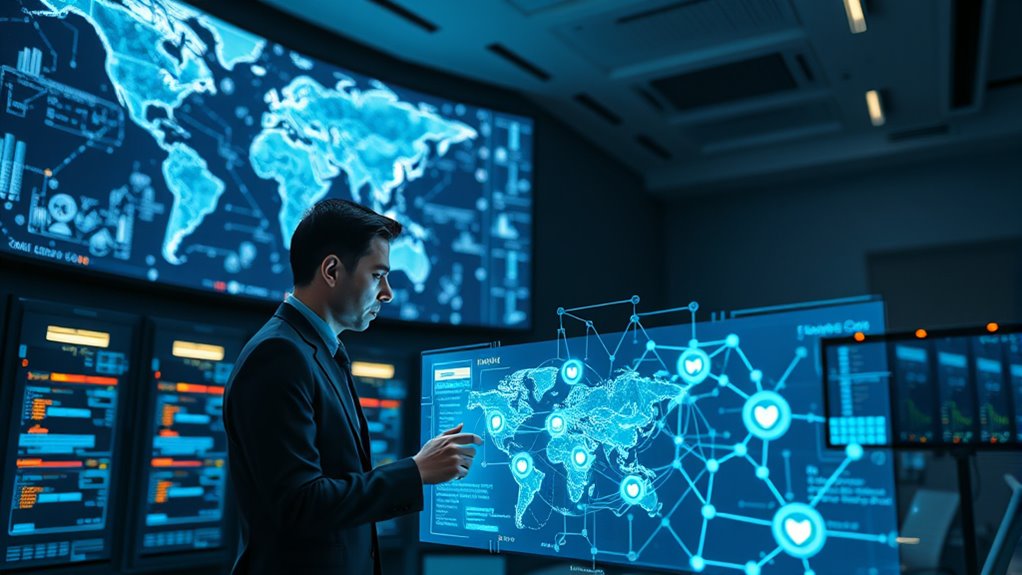AI transforms enterprise cybersecurity by enabling you to detect threats early and respond faster. It analyzes large amounts of data in real-time, spotting subtle anomalies that traditional tools might miss. AI automates routine security tasks, reducing errors and freeing your team to handle complex issues. It also learns continuously from new threats, helping you stay ahead of cybercriminals. To build resilient defenses and understand more about protecting your enterprise, keep exploring how AI can enhance your security strategy.
Key Takeaways
- AI analyzes vast data in real-time to detect and respond to emerging cyber threats proactively.
- Automation powered by AI reduces human error and speeds up threat detection and mitigation processes.
- Continuous learning from global threat intelligence helps AI adapt to evolving cybercriminal tactics.
- AI enhances traditional security measures by identifying subtle anomalies and early signs of breaches.
- Integrating AI into cybersecurity strategies creates resilient, adaptive defenses to safeguard enterprise assets.

Artificial intelligence has become a powerful tool in cybersecurity, transforming how organizations detect and respond to threats. You now have access to advanced systems that can analyze vast amounts of data in real-time, identifying patterns and anomalies that might indicate malicious activity. Instead of relying solely on traditional signature-based defenses, AI enables you to anticipate and prevent attacks before they cause damage. This proactive approach is vital because cyber threats continue to evolve rapidly, often outpacing conventional security measures.
With AI-driven tools, you can automate many routine tasks, such as monitoring network traffic, scanning for vulnerabilities, and verifying user identities. This automation not only reduces the risk of human error but also frees up your security team to focus on more complex issues that require human judgment. For example, machine learning algorithms can detect subtle irregularities in login patterns or data access that may escape manual review, alerting you to potential breaches early. As a result, response times shorten dramatically, and you can contain threats before they escalate.
Furthermore, AI enhances your ability to analyze threat intelligence from multiple sources, including dark web forums, social media, and global security feeds. By continuously learning from new data, AI models improve their accuracy over time, giving you a more exhaustive view of emerging threats. This continual learning process helps you stay one step ahead of cybercriminals who constantly adapt their tactics. You can also leverage AI to simulate attack scenarios, testing your defenses against sophisticated threats and identifying vulnerabilities before attackers do.
Additionally, integrating Hackathons into your cybersecurity training can accelerate the development of innovative AI solutions and foster a community of skilled professionals dedicated to security advancements. However, integrating AI into your cybersecurity strategy isn’t without challenges. You need high-quality data to train your models effectively; inaccurate or incomplete data can lead to false positives or missed threats. Additionally, attackers are developing AI-powered tools to evade detection, creating a constant arms race that demands ongoing refinement of your systems. You must stay vigilant, updating your AI models regularly and combining them with traditional security practices to ensure thorough protection.
In essence, AI empowers you to build a more resilient defense system by providing faster detection, smarter responses, and continuous adaptation to new threats. It transforms cybersecurity from a reactive discipline into a proactive, dynamic process. While AI isn’t a silver bullet, when used correctly, it greatly enhances your ability to safeguard sensitive data, maintain operational continuity, and defend against the ever-changing landscape of cyber threats. Embracing AI in your security approach isn’t just an option anymore; it’s a necessity to stay protected in today’s digital world.
Frequently Asked Questions
How Does AI Detect Zero-Day Vulnerabilities?
AI detects zero-day vulnerabilities by analyzing patterns and anomalies in network traffic and system behaviors. It continuously monitors your systems, identifying unusual activities that may indicate an unknown threat. Machine learning models learn from vast data, spotting subtle deviations that humans might miss. When AI flags a potential zero-day, it alerts you quickly, enabling swift investigation and mitigation before attackers exploit the vulnerability.
Can AI Predict Future Cyberattack Trends Accurately?
You can’t afford to ignore this—AI is remarkably good at predicting future cyberattack trends, often outpacing traditional methods. While it’s not clairvoyant, AI analyzes vast data sets, identifies patterns, and anticipates emerging threats with impressive accuracy. This proactive approach helps you stay one step ahead of cybercriminals, reducing risks and strengthening your defenses. Keep in mind, though, AI’s predictions aren’t perfect, so combining it with human expertise is your best bet.
What Are Ai’s Limitations in Real-Time Threat Response?
AI’s limitations in real-time threat response include its inability to fully understand context and adapt quickly to novel attack methods. You might find that AI systems can detect known threats efficiently but struggle with zero-day vulnerabilities. Additionally, AI can generate false positives, causing unnecessary alerts. While AI accelerates response times, you still need human oversight to interpret complex threats and make nuanced decisions, ensuring thorough security.
How Is AI Used in Insider Threat Detection?
Like a vigilant guardian, AI scans for insider threats by analyzing user behavior patterns and flagging anomalies. You rely on AI to detect deviations from normal activity, such as unusual login times or data access, which may indicate malicious intent. It continuously learns from new data, helping you catch potential insiders before damage occurs, much like a loyal sentinel watching over your enterprise’s secrets.
What Ethical Concerns Arise With AI in Cybersecurity?
You might worry about privacy violations, as AI can monitor employees’ activities extensively, raising concerns about surveillance. There’s also the risk of bias, where AI could unfairly target certain groups, and accountability issues if decisions go wrong. Plus, relying heavily on AI might lead to ethical dilemmas around consent and transparency. Balancing security benefits with respecting individual rights becomes vital as you integrate AI into cybersecurity practices.
Conclusion
As you integrate AI into your cybersecurity strategy, you’re better equipped to detect and respond to emerging threats. For example, imagine AI quickly identifying unusual network activity during a cyberattack, halting it before significant damage occurs. By leveraging AI’s capabilities, you protect your enterprise’s data and reputation. Embrace these technologies now, stay vigilant, and turn AI into your strongest defense against the evolving landscape of cyber threats.










